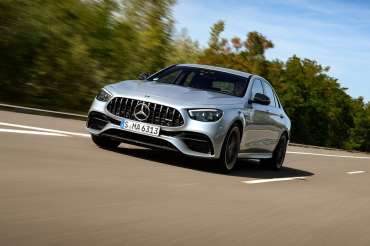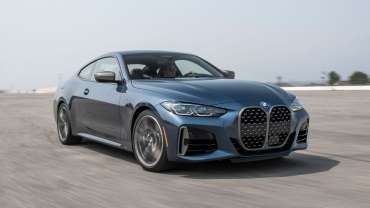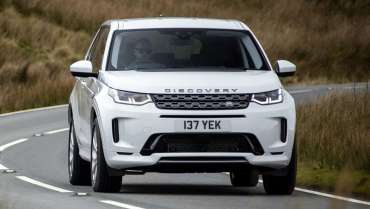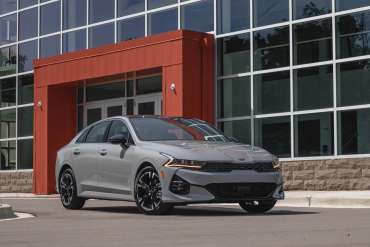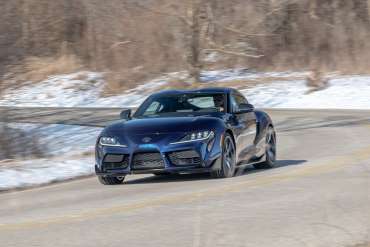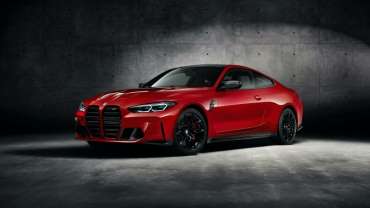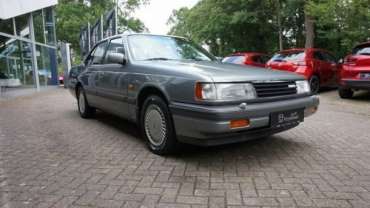
Worldcarblog.com
2021 Mercedes-AMG E63 S Does It All (PHOTOS)
AMG's updated 603-hp E63 S is a multi-talented rocket that can play a limousine or a sports car all the way to its top speed.
The V-8-powered sports sedan is rapidly becoming an endangered species, making the arrival of the revised Mercedes-AMG E63 S a timely reminder that there won't be too many more examples of what is one of our favorite automotive genres. AMG has already admitted that its next-gen hybridized powertrain will be based on a four-cylinder engine, and even if that boasts an output to match (or surpass) the 603-hp twin-turbo V-8 in the E63 S, we can't imagine it will get close on character.
But before we call the mortuary, the E63 S remains a spectacularly talented all-rounder, with none of the E-class's midlife revisions having altered its ability to deliver huge, effortless speed. And it was happy to prove this in spectacular style in its most natural European environment—the passing lane of a German autobahn. As traffic cleared on the A13 near Dresden and the dawdlers happy to cruise at a mere 90 mph or so headed right, the AMG proved its ability to deliver seat-squashing g-forces and a heady V-8 soundtrack with a total lack of untoward drama. It felt as though acceleration barely diminished as the speedometer needle swept past 120 mph, where most fast cars begin to really struggle with the wind, and continues to pull strongly even beyond 155 mph, where lesser AMGs suffer the intervention of their electronic governor. We couldn't find a quiet enough stretch to confirm a top speed for the E63 S, but AMG says its more permissive limiter won't call time until 186 mph.
While such antics are fun, they only represent a small part of the E63 S's appeal. This remains a performance sedan as good at everyday speeds as it is at stratospheric velocities, handling the real world with very nearly the same level of refinement as its less powerful siblings, thanks to the transformative effect of its switchable dynamic modes. Comfort mode turns the E63 S into a limousine, with supple air springs and adaptive dampers doing an outstanding job of digesting road imperfections and the nine-speed automatic shifting early to make the most of every last drop of premium gasoline. The peak 627 pound-feet of torque is available between 2500 rpm and 4500 rpm. The gentlest mode is almost too civilized for something so potent, with AMG's engineers admitting they slightly softened the facelifted car's suspension in response to customer feedback.
If we were most buyers, we’d treat the firmer Sport mode as the everyday default, as it puts some pep into the E63 S's responses and some rasp into its exhaust note without adding undue harshness. Beyond that lies Sport Plus, which puts a noticeable edge on the damping, and the full-on Race mode, which turns the AMG into a snarling monster. Adaptive dampers, the switchable exhaust, and ESP modes can all be controlled separately, and there is still a Custom mode for the hard to please.
While the standard nine-speed shifts both cleanly and quickly, its continued use of a multiplate clutch pack instead of a torque converter—to help sharpen responses and enable high-rpm launches—does have a small impact on low-speed refinement, with the sense that engine and wheels are sometimes being connected with too much suddenness.
The E63 S controls its mass exceptionally well, feeling agile and wieldy for something its size and weight. Its curb weight is around 4600 pounds, but the accurate steering has good feel and delivers both arrow-straight high-speed stability and decisive cornering responses. Selecting the more aggressive dynamic modes brings a rearward bias to the torque distribution of the E63 S's standard all-wheel-drive system, but it takes the (likely rare) selection of the car's Drift mode to turn it into a tire-smoking rear-driven hooligan. While we obviously needed to sample this function in the interests of scientific discovery, we suspect that few buyers will use it often. "Aerodynamically optimized" 10-spoke, 20-inch wheels are standard, and the car we sampled also came with the optional carbon-ceramic brakes, an upgrade that provided predictably indefatigable stopping power.
The world might be losing interest in sedans, but—as with the lesser members of its clan—the E63 S has been given a facelift more substantive than the sort of gentle tinkering normally reserved for a midlife sharpening. A new front end features a vertically slatted radiator grille inspired by that of the original 300SL, with the oversize Mercedes star in the center now housing some of the sensors required for the lane-and-distance-keeping Drive Pilot smart cruise control.
As before, the cabin remains spacious, smart, and extremely well equipped, proving that leather and carbon fiber can play nice together. But as with its regular sisters, moving the E63 S onto the latest MBUX infotainment system has created additional complication and a fair amount of ergonomic confusion. Changing horses midstream (as it were) has required the E-class to effectively accommodate two different interface systems. So, the new car keeps the pre-facelift model's rotary dynamic mode selector on the center console, as well as exhaust, gearbox, damper, and stability switches. These functions, however, are all replicated by the two new rotary controllers (with neat integrated screens) mounted to the steering wheel.
The wheel itself features double spokes on each side, these seemingly required just to allow sufficient space for all the controls it now carries. Despite all of this—and the presence of a voice assistant summoned by saying, "Hey, Mercedes"—some common functions remain hidden within the myriad of submenus. This is a car that makes it considerably easier to change damper settings than to select a new radio station.
We're promised that the revised E63 S will be with United States dealers by the end of the year, with a $108,550 base price putting it between the regular BMW M5 and the M5 Competition. The AMG might not have quite the level of focus of its most obvious competitor, but it sounds superior and—thanks to its personality-changing dynamic modes—has a broader spread of talents. Cars such as these won't be available for much longer. We will miss them when they're gone.
Source: caranddriver.com
2021 BMW M440i First Test: Not Just a Two-Door 3 Series (PHOTOS)
It drives better than it looks but doesn’t justify those M badges. Is that a bad thing?
Mt. Baldy road is hardly more than an hour's drive from downtown Los Angeles, yet it evokes European alpine passes—those that lead from metropolises to epic vistas and crisp mountain air. Breaking off from the freeway, it crosses a quiet suburb before opening into long sweepers weaving up the hillside. In the final climb, it crinkles into tight switchbacks before terminating at a tiny rural ski resort. It's the type of road cars like the BMW M440i xDrive were made for.
No longer is the 4 Series simply a two-door 3 Series. As that iconic sedan preserves its dynamic focus, the 4 Series evolves and now offers a blend of luxury and performance once reserved for BMW's highest-end models. It's a balance that'll leave some drivers in bliss and others wanting more.
Is The M440i Quick? Yes...
Behind those atrocious oversized kidney grilles is a smooth, turbocharged 3.0-liter I-6 making 382 hp and 364 lb-ft of torque, sent through an eight-speed automatic to BMW's xDrive all-wheel drive system. It's a potent setup. Using the sportiest drive modes and a bit of pedal overlap, the M440i leaps to 60 mph in 4.0 seconds flat, and cuts the quarter mile in 12.6 seconds at 110.2 mph.
Acceleration is the most M-ish thing about this car—to 60, it's as quick as an X3 M Competition and not far off the pace of the last-gen M3. Yet the M440i's engine is just as happy to calmly loaf about as it is to rush to redline. All the while it revs with a sweet (but perhaps digitally enhanced) growl.
Swat the paddle shifters and gears change obediently, even if they aren't dual-clutch fast. Grab an upshift under heavy throttle, and the car replies with a nice little kick. Or, just leave it in automatic and cruise, letting its computers softly select the right gear.
M-emblazoned brake calipers clamp ventilated rotors for a 109-foot stop from 60 mph. That deceleration splits other performance-oriented BMWs; the M340i stops in 111 feet and the M2 Competition in 106 feet. The brakes feel reactive and provide a linear buildup of stopping power. But pedal stroke is long, making it hard to gauge how much of a press is needed to get the desired effect. The reactivity makes them a bit grabby at lower speeds, while the long stroke didn't inspire confidence when approaching those mountain hairpins.
With MotorTrend test boss Kim Reynolds at the wheel, the M440i posted a 24.7-second, 0.78g-average lap on the figure-eight course. On the skidpad, it stayed stuck up to 0.93 g. That's impressive when put into context against other sporty all-wheel-drive cars. The Quattro-packing Audi S4 lapped the figure-eight in 25.2 seconds at 0.75 g. The Mercedes C43 with AMG-ified 4Matic did the same in 24.8 seconds at 0.77 g. Both circled the skidpad at 0.91 g. After assessing the 4 Series, Reynolds called it a "very powerful car that's propelled fast to the next corner with modest tail-out drift exiting."
...But Is It Fun To Drive? Not Quite.
True as that may be on the test track, don't expect the xDrive system to provide tail-happy hijinks without serious provocation. Drivers with sub-Reynolds skill levels will find it feels as all-wheel drive as can be. On Mt. Baldy's switchbacks the M440i was extremely reluctant to rotate, instead rounding the bends with staid neutrality. Going to throttle early just brought understeer with overly cautious stability control intervention. On sweeping curves it provided superb high-speed composure but little excitement. And this was in Sport Plus mode, in a car equipped with the "ZTK" cooling and high-performance tire package.
Further undermining the numerous M badges is the paucity of steering feel. Like in the M8 Competition, the abject lack of sensation coming through the wheel results in a dilution of fun. It feels numb, insulated from whatever's going on under the front tires, not made better by its lightness and somewhat slow ratio. Sure, it's accurate, and the car goes where the driver wills it. But it's not quite agile, while the anesthetized sensations make grip levels vague. That mystical bond between driver and machine that BMWs were once known for simply isn't there.
Also lacking feel is the ride—but that could be a good thing, because here the M440i feels more like a grand tourer than a sport coupe. Whereas 3 Series models with M Sport suspension hammer their occupants over every road imperfection, the M440i rides comfortably, effectively erasing cracks and chatter, only ever slightly rough over large potholes. Although it's compliant and not floaty, more feeling through the suspension would give a better sense of connection to the road during spirited driving. Any other time? It's luxe.
Continent-cruising comfort persists in the cabin. The plush front seats feel like lounge chairs with side bolstering. In a real surprise the back seats are actually somewhat usable. There's a decent amount of space, and dedicated air vents, USB ports, and storage cubbies show that BMW didn't make the 4 Series' second row an afterthought. Faultless driver-assist technologies make highway driving a breeze.
Although the 12.3-inch digital gauge display isn't as customizable as equivalents from German competitors, BMW's latest iDrive revision is more user-friendly, and its 10.3-inch touchscreen is bright and clear. Crisp, thumping sound pours out of the optional 16-speaker Harman Kardon premium audio system. Material quality is high, although the layout is essentially identical to any other current BMW, a mere evolution from the previous 4 Series. A more inspired interior seems warranted for a car that makes such a daring design statement outside. Then again, perhaps the austere cabin offers a refuge from the sight of that egregious grille.
Is The M440i A Proper M Car?
There's no doubt that the M440i drives better than it looks. Understand, though, that it isn't a 3 Series coupe. Like the finest GT cars, the M440i is capable but distances its driver from the machinery underneath. It's powerful, poised, and easy to drive fast. Yet there's incredibly little sensation of speed, and the feelings of connection and involvement that true driver's cars offer are all but absent. Maybe the M4 will fix that.
Instead, the M440i feels more like a miniature 8 Series: a smooth, calm haven to cruise in that'll still indulge in full-throttle blasts. Like a proper grand tourer, it'll waft through town, tear across interstates, and oblige some corner carving—exactly as it did up Mt. Baldy road. Just don't be misled by all those M badges.
Source: motortrend.com
New Land Rover Discovery Sport PHEV 2020 review (PHOTOS)
The Land Rover Discovery Sport P300e plug-in hybrid promises 135mpg and an all-electric range of 38 miles, but does it deliver?
Verdict
The switch to plug-in electrification does bring a compromise or two to Land Rover’s most affordable family SUV. You’ll need to accept it as a five-seater only, and it comes with a pretty hefty price that may put off private buyers. But for company car choosers, the considerable BiK savings are impossible to ignore; this is a very practical vehicle that is still good to drive, and suddenly more affordable.
The Land Rover Discovery Sport really upped its game when it switched platforms as part of a mid-life update last year. Mild-hybrid power helped the family SUV to deliver much-needed efficiency gains - but now there’s the option of a plug-in hybrid version that could be ideally suited to daily commutes and school runs.
The Discovery Sport P300e shares its basic powertrain with the newly launched Evoque P300e. That means a 1.5-litre three-cylinder petrol engine driving the front wheels, and 107bhp electric motor on the rear axle, delivering four-wheel drive when required. There’s 15kWh battery, too - enough, Land Rover claims, for the car to travel up to 38 miles on electric power alone. With a Benefit-in-Kind tax rating of 10 per cent, that should make this Disco Sport a hefty chunk cheaper for company car choosers than any of its siblings.
The adoption of the part-electric powertrain doesn’t affect the Disco Sport’s four-wheel drive credentials; the electric motor on the back axle is always on standby for slippery conditions and off-roading, even if the official battery capacity is at zero. It does remove the possibility of the Disco Sport’s occasional third-row seats, sadly - but the boot capacity beyond the second row is still cavernous, at 963 litres.
If you’re wondering if a three-cylinder engine-based powertrain can have enough shove to cope with such a practicality-focused model, you needn’t worry. The instant torque from the electric motor allows the Disco Sport to glide around town without much effort at all. It would feel quite at home completing a week’s worth of short school runs on EV power alone, frankly - and the ability to go from zero to 80 per cent of battery capacity in less than 90 minutes on even a 7kW home wallbox would make overnight recharges very easy indeed.
The car’s behaviour on the open road is a slightly different matter. We’ve been impressed with the P300e powertrain’s smooth transitions in the Evoque and that trait is present and correct here too, we’re glad to report. Keep the Disco Sport in Hybrid mode and should you extend the system to the point where the engine kicks in, you’ll barely notice the start-up. In this area at least, Land Rover’s is among the best set-ups that we’ve experienced.
The engine itself, though, is definitely more vocal in the Disco Sport than it is in the Evoque. It doesn’t appear to be revs-related either, but there are harmonies and chirps allowed through to the cabin in the Disco that simply aren’t present in its smaller, style-focused stablemate. We’re bemused by this - the installation ought to be damn-near identical - but perhaps there’s a layer of soundproofing that gets applied to Range Rovers but not to Land Rovers.
Either way, just accept that you will get some three-cylinder grumble here - but in the grand scheme of things it’s probably no worse than what you’d experience with a modern diesel. And as with the Evoque, you can use a natty gauge in the instrument panel to temper your attitude on the right-hand pedal and, battery level permitting, prevent the engine from being called upon at all, particularly around town.
The drive itself is every bit as accomplished in P300e form as it is in regular Disco Sports. The transmission in the PHEV is an eight-speed auto (compared with nine-speeds elsewhere in the range) but it’s a solid performer, smart enough to work with the driver and delivering smooth shifts when required.
There’s no getting around the fact that this is a tallish SUV, so there’s a bit of body roll in corners, but in general it’s well controlled and there’s bags of grip to give you confidence, even in slippery conditions. The steering remains slower than in the Landie’s German rivals, but it’s precise enough and makes it easy to place the car in corners. Front visibility is still a strong point, too, and the ClearSight digital rear-view mirror helps to eliminate blind spots behind you.
The 2021-model-year Discovery Sport gets Land Rover’s latest Pivi Pro infotainment system, which is a huge leap over what was previously offered. It delivers proper smartphone integration and the system has quick to respond to inputs.
Curiously, the P300e is being restricted to R-Dynamic editions of the Discovery Sport - although you at least have the option of S, SE and HSE once you’ve ticked that initial box. That means you get plenty of kit, even at the entry point that we’ve driven here, but it does bump the price up to the point where private buyers would need to think hard about the potential savings on running costs.
Source: autoexpress.co.uk
Tested: 2021 Kia K5 GT-Line Draws Closer to Excellence
With striking style and an upscale interior, Kia's new mid-size sedan is some chassis refinement away from rivaling the leaders in its class.
Children don't sketch SUVs in study hall and car designers don't spend years in school working their way up to studio boss to figure out how to draw a grille and headlights on a potato. The designers we know dream of penning performance cars, and while the 2021 Kia K5 isn't exactly that, it definitely looks like one.
"Longer and lower with a wider track" sounds like a Chevy ad from the '50s, but those descriptors belong to Kia's mid-size sedan, too. Compared with the Optima it replaces, the K5 measures two inches longer and nearly an inch lower and has an extra 0.8 inch between the tires. The proportions and design yield a striking car that belies its front-drive layout, the $24,455 starting price. We drove a GT-Line model with an asking price of $27,955, but a mechanically identical EX went to the test track and that's where the numbers came from. Aesthetes who find the Honda Accord and Toyota Camry too common might not turn their noses up at the K5.
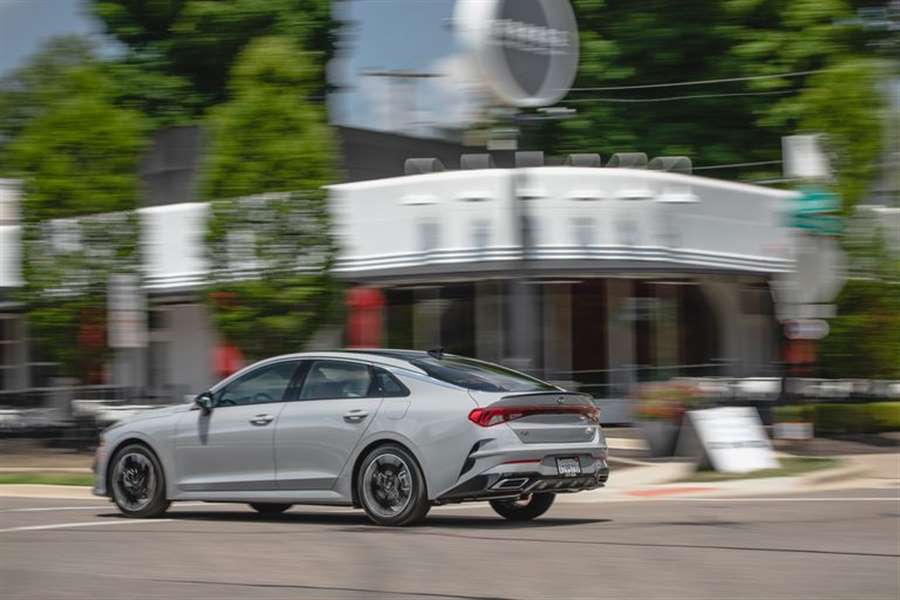
While the styling pleases eyes, the K5 is satisfying in many other ways. The base engine is a 180-hp turbocharged 1.6-liter four shared with the Sonata, and it's paired to an eight-speed automatic—no rubber-band CVT here. Shifts are smooth and quick, and the right gears are called up without any fuss. Low-end torque feels more abundant than its peak of 195 pound-feet at 1500 rpm indicates, and the turbo makes itself felt right away. Stomp it and the K5 gets to 60 in 7.0 seconds.
Venture beyond 5000 rpm and the engine moans, something you won't hear in an Accord. Driven more sedately, the K5 hums 67 decibels of sound into the cabin at 70 mph. All GT-Line and EX models have the same suspension tuning as the base K5, but they use 18-inch wheels with wider Pirelli all-season tires than the entry trim's 16s. Sharp impacts expose a lack of isolation. While not a deal breaker, it's worth noting that an Accord sops up the same hits with less coarseness. It's likely the shorter sidewalls of the 18-inch wheels and the one-size-fits-all tuning are to blame. The steering is both unerringly stable at highway speeds and deft and responsive when you're sawing through a canyon road or interesting on-ramp.
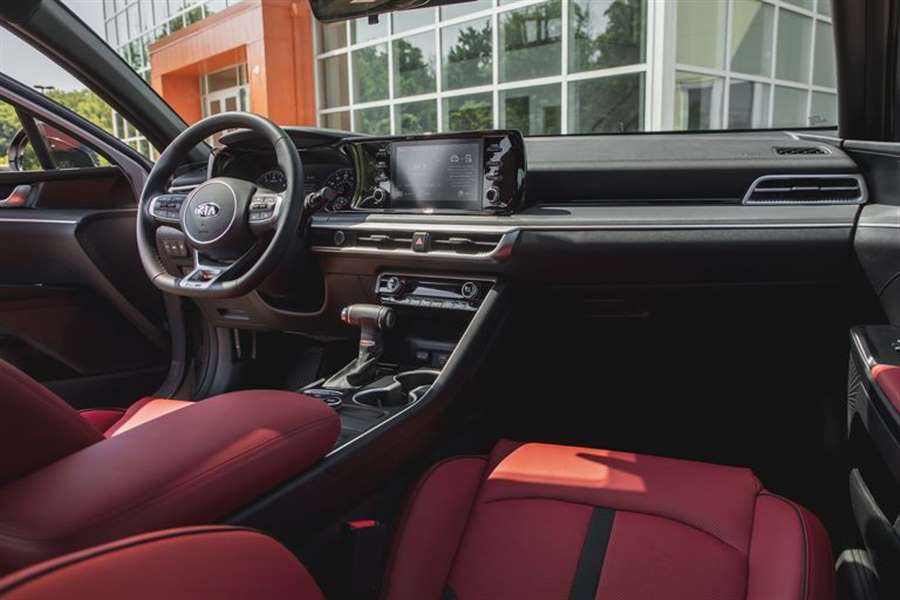
A radically angled windshield lends a sports-car mood to the driving experience, and the seating position is excellent. Rear-seat space is generous and comfortable. A 10.3-inch touchscreen is available on some trim levels, but the GT-Line comes with an 8.0-inch screen. Both sprout out of the dash and are flanked by physical buttons that make switching between functions easy. The instrument panel has a BMW-ness to it, and material quality throughout the cabin is good. Apple and Android phone mirroring is wireless on all models with the standard 8.0-inch infotainment screen, but strangely, you'll need a cable if you upgrade to the 10.3-incher.
The K5 inches closer to the Accord's ability to deliver everyday joy. A bit of suspension tuning to increase isolation and refinement would give it the manners to match its designer looks.
Source: caranddriver.com
Our 2020 Toyota Supra 3.0 Wows Wherever It Goes (PHOTOS)
Toyota's sexy sports car proves it has the presence to match its thrilling performance.
We've been driving our Toyota Supra 3.0 for eight months and 10,811 miles, and in that time we've learned something about it that no amount of track testing or comparison test battles could have predicted: that it would have instant street cred. For many people, our Downshift Blue Supra was the first they'd ever seen—Toyota has sold only 3798 through September—and it continually draws admiring looks, lustful glances, and a steady stream of "oohs" and "what's that?" In the court of public opinion, it's one killer sports car. We couldn't agree more.
Manufacturers build cars like the Supra in part to cast a halo over the rest of their lineup—they're actually called halo cars in industry parlance—and to burnish the reputation of the parent company that makes them. The Supra is doing exactly that. As Exhibit A, we offer some observations that our staffers have penned in the Supra's logbook.
"A man in a Honda Fit followed me to a Jimmy John's drive-through," wrote staff editor Austin Irwin, "parked, and walked over and asked to take a photo of the car. Another guy flagged me down at a Taco Bell to tell me his brother had a Supra from the 1990s." (Eating a lot of fast food these days, Austin?—Ed.) Then there was the robotics engineer who circled the Supra in yet another parking lot and exclaimed, "You bastards. You got the new Supra. Seeing this car, I'm going to buy one."
After driving the Supra for a two-week span, editorial operations manager Juli Burke reported, "I got a lot of long, longing looks from car fans." Print director Eric Tingwall observed, "This car attracts constant attention from males ages eight to 40. They all know it's a Toyota Supra, they think it's cool, and those who are aware that BMW builds it could not care less about its origins." He added, "The Supra appears to be rehabbing Toyota's beige reputation far more successfully than the Scion FR-S/Toyota 86. This is a halo car doing exactly what halo cars are supposed to do."
Indeed, what the citizenry inferred from the Supra's muscle-bound sheetmetal is exactly what it's been delivering from behind the wheel. We've already reported on its ripping performance—60 mph in 3.7 seconds and 1.05 g of skidpad grip. Speed and handling would never be an issue; what we wanted to know was what it was like to live with.
So far, so good. Our first 10,000 miles were accumulated virtually all within Michigan's borders thanks to COVID-19 concerns. But ours is a big state, and our drivers crisscrossed it multiple times visiting the burgs of Gaylord, Oscoda, South Haven, and the famous Warren Dunes State Park in Sawyer. We used it for weekend getaways as well as for daily commutes and grocery-store runs.
But nothing we did with it dulled its shine. Our admiration starts with the BMW-sourced turbocharged 3.0-liter inline-six, which propels our 2020 model like it has more than the claimed 335 horses. The 2021 models receive a bump to 382 horsepower. And we confirmed our car's status as an overachiever with a chassis dynamometer test. "I hope BMW charged Toyota a lot of money for this engine," said director of vehicle testing Dave VanderWerp, "because it's one of the greats." Assistant technical editor Max Mortimer added, "I love how rowdy and pure the exhaust note is." Nail the throttle at 10 mph and the Supra lights up its rear tires, the engine lunges for the 7000-rpm redline, and the exhaust blats out the howl of a thousand angry bloodhounds.
But hit the highway and the Supra settles down to a civilized cruise. "It did surprisingly well on a 600-mile weekend road trip," said VanderWerp. "Highway ride is very reasonable, and the tires only get really noisy over the rare concrete sections." Irwin added: "I love the seating position, low like a race car but within reach of the controls. Drive anything else after a week in the Supra, and you'll feel like a substitute bus driver."
On longer trips, the Supra surprised us with how parsimonious it was with fuel. During VanderWerp's weekend getaway to Michigan's northern regions, he noted, "Even when cruising at 80 mph, the trip computer was showing 35 mpg. Amazing." And despite our heavy-footed treatment in local driving, the Supra's average fuel economy to date is 24 mpg.
Inevitably, spending months with any car brings its weak points into focus, and the Supra has several. There has been no agreement on seat comfort. Our tallest driver liked the leather-covered buckets just fine, while an average-sized driver complained of the fit. But both agreed that the Supra's sexy styling, with its low roof and slits for windows, hurt visibility to all sides and made traffic lights hard to see without scrunching down in the seat. Its down-low proportions had even our youngest and most limber staffers complaining about how awkward it is to climb in and out of.
And don't even try to drive it with the windows down. Something about the Supra's bulging shape creates buffeting inside the cabin so vicious that by 55 mph your left hand involuntarily reaches for the window switches. "Heartbreaking," Irwin said. "I want to hear all of the exhaust sound and feel the wind rush." We'd also like more interior storage space, an exterior release button for the rear hatch, and a fuel gauge with markings that are easier to decipher. But really, everyone who cites a complaint about the Supra ends up saying how much they like it nonetheless.
We started this test wondering if a car jointly developed by two companies with very different engineering philosophies would introduce reliability issues that neither would have had if they built the car alone. If the first 10,000 miles are any indication, the answer is no. The Supra's service record has been as impeccable as we'd hope for if it were a Camry. It just received its first required service, an oil-and-filter change and a multipoint inspection, that cost $210. Beyond that, it has spent zero time at the dealer for unscheduled maintenance.
We couldn't be happier with it as we continue to pile on the miles. Time stuck in the shop means less time on the road. And no one around here wants to miss a chance to wrap their hands around the Supra's steering wheel and revel in its straight-six's joyful shouts.
Introduction
We are not putting the new Toyota Supra though a 40,000-mile long-term test to explore how we feel about it. We already know that it's quite good and that we like it a lot. To see how deep our respect for this killer two-seater goes, just follow the editorial breadcrumbs that we've dropped over the past year or so.
We heaped praise on the Supra the first time we drove it. We thought it was hot enough to pit against the BMW M2, Ford Mustang Shelby GT350, and Porsche 718 Cayman in a comparison test—and then against a BMW Z4 roadster in another shootout. It was so quick in our testing that we strapped it to a chassis dyno to verify its horsepower rating, which turned out to be more than Toyota claimed. We pushed it to the limit in our 2019 Lightning Lap track event, where it impressed. And then we gave it a 10Best award, the highest honor we can bestow on a new vehicle. Now we're filling in the missing part of the picture: how this brilliant sports car holds up to the daily grind.
There's a reason for our heightened curiosity about the Supra's long-term dependability. Toyotas have a reputation for being impossible to kill, but this is not your average Toyota. It's a mixed breed—part BMW, part Toyota. Toyota leveraged BMW on the Supra project, borrowing what it could from the Z4, much to the dismay of committed fanboys of previous-generation Supras, who wanted the new one to again be pure Toyota.
Whenever two companies with two different engineering cultures attempt to integrate their components and technologies, the door opens to potential glitches. Would this joint-venture car start showing issues somewhere down the figurative and literal road? That's what we're going to find out.
Mechanically, the Supra is more BMW than Toyota. Okay, maybe it's all BMW. Its turbocharged B58 3.0-liter inline-six, ZF eight-speed automatic transmission, electronically controlled limited-slip differential, steering rack, and suspension components are from BMW—the same basic pieces employed in the Z4 M40i. For 2020, Supras are fitted with a 335-hp version of the B58 inline-six, while the Z4 M40i launched with 382 horsepower. For 2021, Supras will get that higher-output engine tune as well.
Inside the Supra's tomb-dark cabin, you'll find more BMW gear, including the German company's electronic shifter, infotainment controls, and audio switches. Toyota was responsible for the Supra's exterior and interior design, the engineering of its body shell, and how its ride and handling was tuned. But the biggest difference between the two cars is that the Supra is a hatchback and the Z4 only comes as a convertible.
Our Downshift Blue Supra is the mid-grade GR (Gazoo Racing) 3.0 Premium model. Thanks to a full helping of standard comfort and convenience features, it's as much a grand tourer as it is a sports car. Its goodies include heated, 14-way power-adjustable seats covered in black leather; a head-up display; an 8.8-inch touchscreen infotainment system with navigation; automatic climate control; and a 12-speaker JBL audio system. Pre-collision automatic braking with pedestrian detection and lane-keeping assist are standard. To that we added just one major option: the Driver Assist package, which brings adaptive cruise control, blind-spot monitoring, and rear cross-traffic alert with emergency braking. A carpeted rear cargo mat and wheel locks brought the $54,945 base price to $56,285.
When our car arrived in mid-February, we attempted to fit it with a set of winter tires. It was virtually impossible to find a single source that could provide a matched set of high-performance winters in the Supra's size—255/35R-19 in front, 275/35R-19 at the rear. Enter Pirelli, who graciously pulled together a special set of Sottozero Serie II's for us in the correct sizes. "These are the most performance-oriented, street-legal winter tires available," Pirelli claims. Indeed, the fronts are designed for the Lamborghini Aventador, while the rears are intended for the Aston Martin DB9. Who drives their Lambo or Aston in the snow? We want to meet these people. We ultimately found that, between Tire Rack and Summit Racing, you could piece together a similar set for $1350.
Once set up with the proper footwear for foul midwestern winter weather, we eased the Supra through its 1200-mile break-in period, during which time engine revs are supposed to be kept below 4500 rpm and the vehicle below 100 mph—both surprisingly hard to do in a car this swift. With its factory Michelin Pilot Super Sport summer tires reinstalled for its initial outing at the test track, we once again witnessed performance that puts the Supra in the company of some serious high-performance machinery.
Our 3388-pound test car rocketed to 60 mph in just 3.7 seconds and through the quarter mile in 12.2 seconds at 113 mph. It circulated the skidpad at 1.05 g and stopped from 70 mph in 148 feet. Technical editor David Beard reported that it orbited the 300-foot skidpad with its rear end sliding as much as any car he's ever tested. We experienced the same tail-happy tendency in our previous tests, during flat-out laps at Virginia International Raceway (VIR), and on our favorite on-ramps on the winter tires. It's part of what makes the Supra feel exciting and on edge when driven hard. But as print director Eric Tingwall said of his laps in the car around VIR, "It can be a bit much." Toyota revised the Supra's suspension tuning for 2021, and we look forward to seeing if those changes make its rear end less prone to stepping out.
That particular behavior is something you'll only see when pushing the Supra to its limits. In normal driving, it's sweet, encouraging, and fun. It rides well enough to be a long-distance cruiser. It's agile enough to be fun anytime the road squirms. It's fast enough to make you laugh every time you nail the throttle. The BMW six-cylinder sounds fantastic. And its weird-science styling garners plenty of attention. In short, the Supra makes you feel good. Now we'll see if its maintenance requirements and day-to-day livability break that spell or enhance it.
Source: caranddriver.com
BMW M4 design study wears retro red (PHOTO)
The collaboration with N.Y. fashion house Kith is a one-off
BMW's M division has revealed a special 2021 M4 Competition coupe that is a collaboration with a New York-based fashion brand. The joint project with design house Kith has resulted in a unique M4 that is described as a design study.
The car is finished in Cinnabar Red, a factory color offering that was available on the original E30 M3. It was inspired by a Cinnabar Red E30 M3 belonging to Kith owner Ronnie Fieg. According to bmwblog, Fieg shipped his vintage M3 to Germany for a factory restoration. The work included custom elements featuring his company name on the roundels and badging.
The new M4 project is similarly co-branded. The M logo on the trunk lid is modified to read "Kith." The fashion company's name also appears on the custom seat upholstery. Aside from the custom design elements, the car appears to be a stock 2021 M4 Competition coupe. That means it's powered by an S58 twin-turbo straight-six making a mighty 503 horsepower and 479 lb-ft of torque.
As such, this M4 literally is one powerful promotional vehicle for the fashion brand. It's also a one-off. Still, BMW's M division is said to be interested in special projects with artists, so we could see more design collaborations involving M cars in the future.
Source: autoblog.com
Rare Rides: The 1990 Mazda 929, a Traditional Japanese Luxury Sedan
Today marks the second time a Mazda 929 will grace us here at Rare Rides. Late last year we featured the successor to today’s car, a pristine 929 from 1992. That smooth sedan had frameless windows, rounded shapes everywhere, and was designed specifically with the North American market and Lexus customers in mind.
Let’s take a look a the much more conservative luxury sedan Mazda designed before Lexus existed.
The car North America called 929 was known in its home market as Luce. Dating back to its debut in 1967, the Luce was Mazda’s flagship. A smaller manufacturer, Mazda did not field a full-size sedan for some time. Available in coupe, sedan, and wagon formats, the Luce remained mid-size through the ’77 model year. For ’78 the LA4 series Luce grew into a larger executive car, leaving the midsize segment to the Capella (626). In its new larger form the Luce coupe went away, and the model’s three-body lineup was maintained via a standard sedan, hardtop sedan, and a wagon. The market segment of the departed Luce coupe was filled from that point onward by the Cosmo.
The LA4 generation didn’t last for long and was replaced by the HB for 1982. Once more the Luce grew in size. Reflecting future trends early, there was no more wagon in the HB generation, only a sedan and hardtop. The hardtop HB had a very interesting front end treatment, by the way. HB had a good run and remained in production through 1986. The Cosmo continued on the HB platform through the rest of the Eighties, and HB was the last time the two cars shared underpinnings.
For model year ’87, HB became HC, and the Luce experienced another growth spurt. Again available in sedan and hardtop guises, the Luce/929 was sold in two sizes. Hardtop versions were longer and wider, at 194 inches and 67.9 inches, respectively. Standard sedans were 184 inches long, and 66.7 inches wide. Though traditional in its form, Mazda saw fit to offer a zesty Wankel engine in addition to standard I4 and V6 power. Inline-fours were of 2.0- or 2.2-liter guises. There was also a tiny 2.0-liter V6, and (in North American examples) a 3.0-liter V6. Notably, the J-series engine was the first V6 Mazda produced. The rotary option was a 13B, a twin-rotor 1.3-liter mill which was not offered in North America. Some Luce trims were in fact more luxurious than the 929 offered in America, as Mazda reserved its rotary power, adjustable suspension, and console refrigerator for the home market.
Mazda saw fit to import only the sedan to North America, feeling no need to come with hardtop length. Canadians had more options than Americans eh, as they received a standard Winter Package on their 929s. That meant a tougher alternator, winter tires, wipers that didn’t hide themselves under the hood, and heated seats. The vast majority of North American 929s were automatic, but a five-speed manual was theoretically available.
The most notable change in the 929’s timeline on these shores was the addition of the S trim for 1990. The 18-valve SOHC engine was upgraded to DOHC, and 24 valves. Performance and fuel economy both increased with this upgrade; horsepower jumped from 158 to 190. S also added two-tone paint and excellent lace alloys.
The 929 was too dated, too traditional, and a slow seller. Mazda got the most mileage out of its new V6 in North America via the very interesting rear-drive MPV. The 929 was replaced with the previously featured generation in 1992. Worth noting, Koreans absolutely loved the HC 929. Once Mazda stopped building it, they sold the design to Kia. Kia did a light front and rear rework and sold it as the Potentia from 1992 until 2001. The 929-cum-Potentia’s base 2.0-liter engine also saw use in the first generation Kia Sportage for many years.
Today’s Rare Ride is located in Germany because Americans can’t take good pictures when they have a 929 for sale. This V6 asks $10,500.
Source: thetruthaboutcars.com

